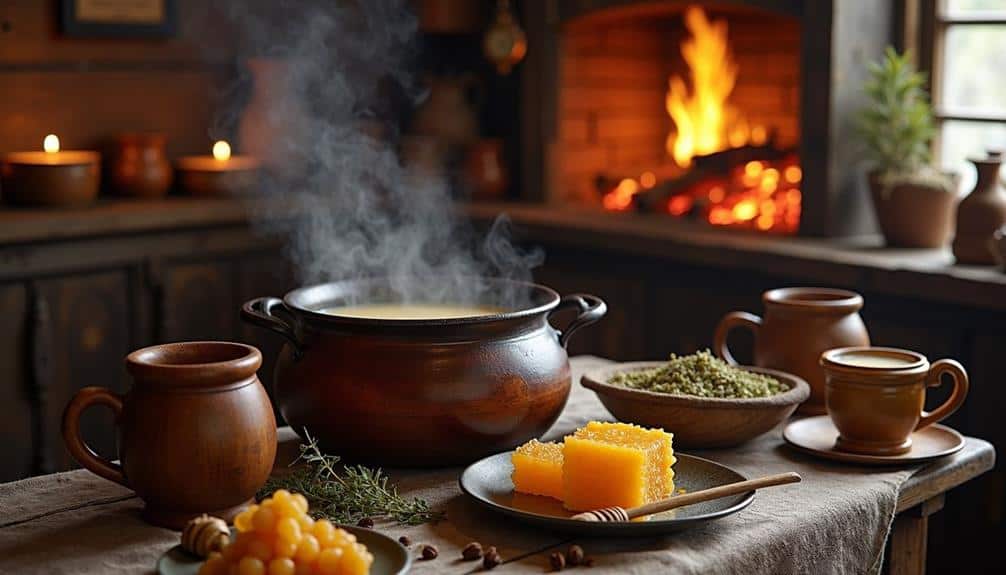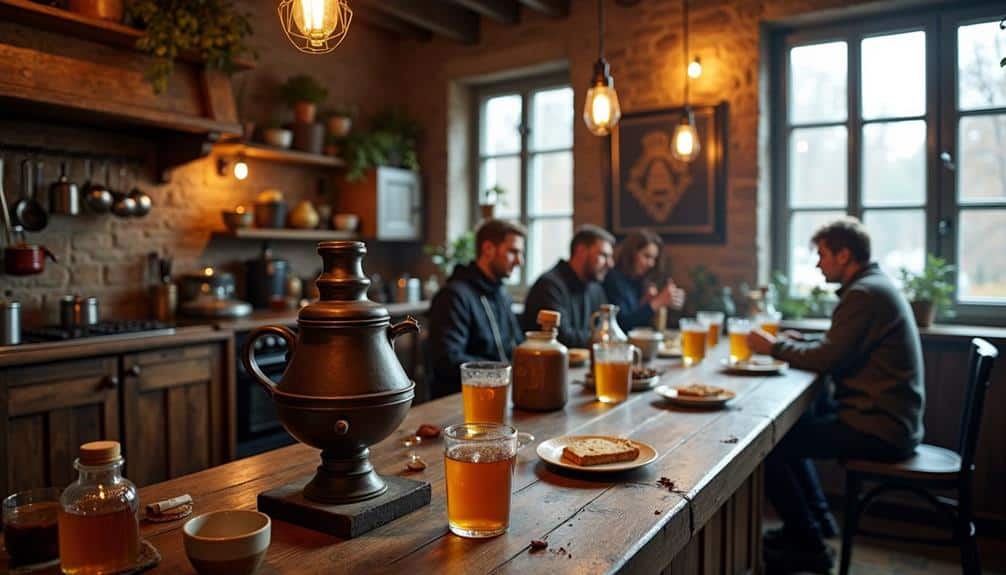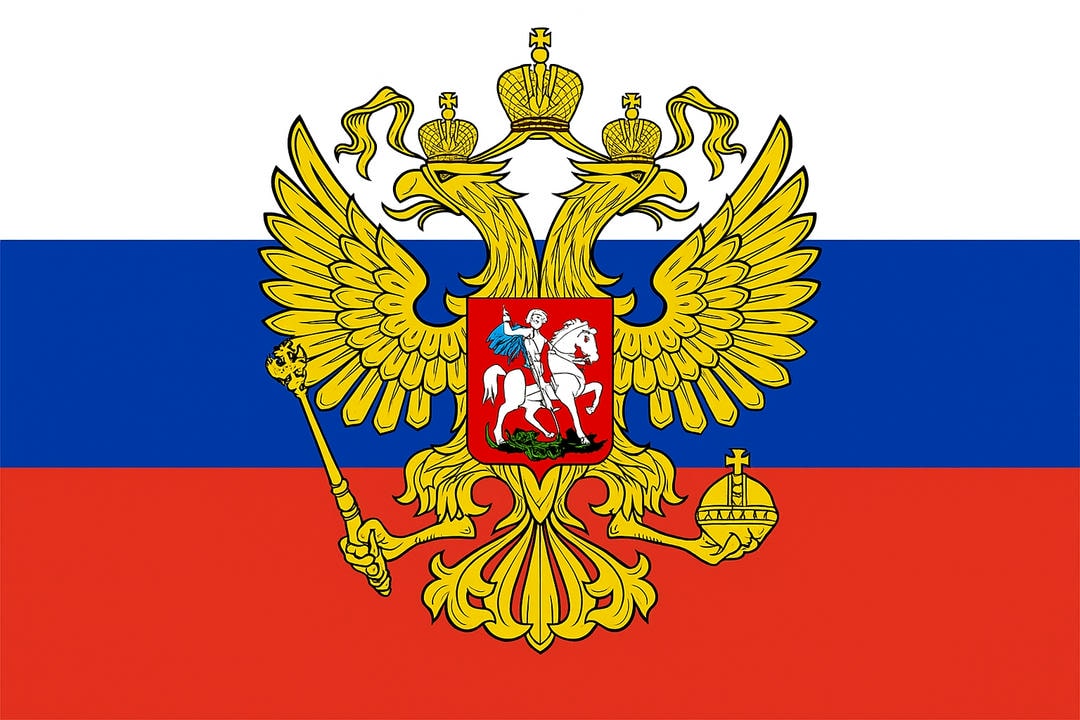Imagine yourself in a bustling medieval Slavic village, where Sbiten, a warm, honey-based drink, is being served in handcrafted ceramic mugs. This traditional beverage isn’t just about taste—it’s a symbol of hospitality and community, particularly during festive events like Maslenitsa. Its blend of water, honey, and spices showcases local flavors while also reflecting historical trade routes. But did you know Sbiten also had medicinal uses, especially in brutal winters? As Western beverages gained popularity, Sbiten’s presence waned, only to see a resurgence in recent years. Curious about how this revival connects to Russia’s heritage?
Origins of Sbiten

Sbiten, a traditional Russian beverage, traces its roots back to the early medieval period, emerging as a staple in Slavic culture long before the advent of tea and coffee.
In its historical context, Sbiten served not just as a drink but as a symbol of communal and social interaction in Slavic societies. The beverage was commonly sold by street vendors and consumed in taverns, illustrating its role in public life and community gatherings.
Understanding regional variations of Sbiten is essential for appreciating its cultural significance. Different regions of Russia adapted the drink to suit local tastes and available ingredients.
For instance, northern regions often incorporated a higher concentration of honey, reflecting the abundance of beekeeping in those areas, while southern regions might add more spices, indicative of trade routes bringing in exotic flavors.
These adaptations underscore the drink’s versatility and its ability to reflect regional identities.
Ingredients and Preparation
When delving into the ingredients and preparation of this time-honored beverage, one uncovers a fascinating blend that showcases both simplicity and complexity. At its core, Sbiten consists of water, honey, and a carefully curated selection of spices. The spices selection typically includes cloves, cinnamon, and ginger, each contributing a unique layer of flavor and warmth to the drink. These spices not only enhance the taste but also reflect the historical trade routes and cultural exchanges that have influenced Russian culinary traditions.
To prepare Sbiten, you begin by heating water and dissolving honey in it, creating a sweet base. The chosen spices are then added, often accompanied by herbs such as mint or sage, which introduce an aromatic quality. This mixture is simmered gently, allowing the flavors to meld and develop a rich, complex profile. The process demands attention and care, ensuring that the honey doesn’t scorch and the spices release their full potential.
Serving traditions play an essential role in the enjoyment of Sbiten. Traditionally, it’s served hot, often in ceramic mugs, emphasizing warmth and comfort. The communal aspect of sharing Sbiten underscores its cultural significance, fostering a sense of togetherness and hospitality.
Medicinal Uses

Exploring its historical context, one finds that Sbiten wasn’t merely a comforting beverage but also esteemed for its medicinal properties. Traditionally, Sbiten was crafted with a blend of honey, water, and various herbs and spices. These ingredients weren’t chosen randomly but for their specific health benefits.
Honey, a primary component, is well-known for its antimicrobial and soothing qualities, making it effective in treating colds and sore throats. In addition to honey, herbs like sage, mint, and thyme were frequently used.
Sage is recognized for its antiseptic and anti-inflammatory properties, while mint aids digestion and alleviates headaches. Thyme, another common ingredient, offers both antibacterial and antifungal benefits. These herbal remedies combined to create a potent drink that provided relief from various ailments.
Moreover, the warmth of Sbiten made it particularly beneficial during the harsh Russian winters, offering both physical warmth and immune support. By understanding its ingredients and their effects, you can appreciate how Sbiten served as more than just a drink; it was a cornerstone of traditional herbal medicine.
This historical use underscores the depth of its cultural and medicinal significance in Russian history.
Sbiten in Russian Festivals
Often celebrated for its rich cultural heritage, Sbiten played a significant role in Russian festivals, weaving together social and ceremonial threads.
You’ll find that during traditional Russian festivals such as Maslenitsa, a week-long celebration marking the end of winter, Sbiten was indispensable. This warm, spiced beverage provided a comforting reprieve from the cold, while also fostering communal bonds around the festive table.
In these gatherings, the preparation and sharing of Sbiten were steeped in tradition. Sbiten recipes were often passed down through generations, each family adding its unique twist. Ingredients like honey, spices, and herbs were meticulously selected to create a brew that was both flavorful and symbolically significant.
The act of making Sbiten wasn’t merely culinary; it was a ritual that signified the welcoming of guests and the celebration of life.
Moreover, Sbiten held a notable place during religious holidays such as Christmas and Easter. Here, it wasn’t just a drink but a symbol of hospitality and unity.
Decline and Modern Revival

As the vibrant scenes of Russian festivals gradually became memories, Sbiten’s presence also started waning, overshadowed by the influx of Western beverages and changing social dynamics. The industrial revolution and globalization introduced tea, coffee, and later, soft drinks, which captivated the Russian populace, leading to Sbiten’s decline. Traditional recipes were forgotten, and commercial production ceased as demand dwindled.
However, the modern era has witnessed a remarkable revival of Sbiten, driven by a renewed interest in cultural heritage and artisanal food and drinks. Enthusiasts and historians have begun to resurrect ancient recipes, while small-scale producers are experimenting with craft variations to cater to contemporary tastes.
You might notice Sbiten appearing in chic cafes and local markets, often marketed as a healthy, natural alternative to mass-produced beverages.
This resurgence isn’t merely nostalgic; it reflects a broader trend towards valuing authenticity and craftsmanship. By embracing both traditional methods and innovative approaches, Sbiten is gradually reclaiming its place in Russian culture.
You can now find it in various forms, from bottled commercial production to bespoke, locally-sourced versions, ensuring that this historic drink continues to evolve and endure.
Cultural Impact
Sbiten isn’t just a beverage; it’s a cultural emblem that embodies centuries of Russian tradition and social customs. When you explore its roots, you’ll discover how deeply it intertwines with cultural rituals and social gatherings.
Historically, sbiten was more than a warm drink; it was a communal experience. In the harsh Russian winters, it provided warmth and comfort, served during festive occasions and religious ceremonies, creating a shared sense of community.
You can appreciate how sbiten played a role in social cohesion. As people gathered around to enjoy its rich, spiced flavor, they also engaged in conversations, storytelling, and bonding. Sbiten was often sold by vendors in bustling marketplaces, where it facilitated social interactions and became a staple in everyday life.
Moreover, sbiten’s preparation and consumption were woven into cultural rituals. Whether used as an offering during pagan celebrations or a comforting drink during Orthodox fasting periods, it held symbolic meaning.
Conclusion
In embracing Sbiten, you’re not just savoring a beverage; you’re partaking in centuries-old traditions that celebrate unity and resilience. This drink, with its rich blend of honey and spices, isn’t merely a recipe—it’s a symbol of Russian heritage. Despite its decline under Western influence, Sbiten’s modern revival underscores its enduring cultural significance. By appreciating its historical and social context, you’re contributing to the preservation of a treasured aspect of Russian identity.




